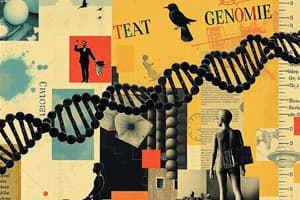Podcast
Questions and Answers
What does the prevalence of a phenotype indicate in a population?
What does the prevalence of a phenotype indicate in a population?
- The total number of traits present in a population
- The ratio of individuals exhibiting a specific trait to the total population (correct)
- The average response of the population to a specific drug
- The genetic makeup of individuals within that population
Which statement best describes a simple phenotype?
Which statement best describes a simple phenotype?
- It results from the interaction of multiple genes and environmental elements.
- It is only influenced by environmental factors without genetic input.
- It has a monogenic basis and can be dominant or recessive. (correct)
- It is always expressed regardless of environmental factors.
In the context of pharmacogenomics, how is genotype related to phenotype?
In the context of pharmacogenomics, how is genotype related to phenotype?
- Genotype and phenotype are entirely independent of one another.
- Genotype is irrelevant to drug response.
- Genotype determines the probability of a phenotype being expressed. (correct)
- Genotype has no impact on phenotype expression.
Which condition is a characteristic of recessive simple phenotypes?
Which condition is a characteristic of recessive simple phenotypes?
What role do environmental factors play in determining phenotype?
What role do environmental factors play in determining phenotype?
What is a primary characteristic of complex traits?
What is a primary characteristic of complex traits?
What does it mean for a phenotype to be expressed in a dominant fashion?
What does it mean for a phenotype to be expressed in a dominant fashion?
How are alleles inherited from parents?
How are alleles inherited from parents?
What is the formula to calculate phenotype frequency?
What is the formula to calculate phenotype frequency?
Which of the following is an example of a complex trait?
Which of the following is an example of a complex trait?
Flashcards are hidden until you start studying
Study Notes
Human Genome Structure
- Approximately 30,000 genes are present in the human genome.
- About 20% of the genome includes introns, untranslated regions, and pseudogenes.
- Extragenic regions make up around 75% of the human genome.
- Repeated sequences constitute 55% of the genome.
- Repetitive sequences primarily consist of transposons, which can insert multiple copies in scattered locations.
Nucleic Acids
- Nucleic acids are carriers of genetic information, composed of two types: DNA and RNA.
- DNA (Deoxyribonucleic Acid) contains deoxyribose, while RNA (Ribonucleic Acid) contains ribose.
- Both nucleic acids feature a sugar-phosphate backbone and nitrogenous bases.
Nitrogenous Bases
- Nitrogenous bases include:
- Pyrimidines: Thymine (T) and Cytosine (C).
- Purines: Adenine (A) and Guanine (G).
- RNA contains uracil (U) instead of thymine (T).
- Base pairing is complementary: A:T and G:C, with G:C bonds being more stable due to three hydrogen bonds compared to two in A:T.
DNA Structure and Replication
- DNA forms a double helix with two anti-parallel strands (5’ to 3’ and 3’ to 5’).
- DNA replication occurs during the S phase of the cell cycle, facilitated by DNA polymerase.
- Leading strand synthesized continuously (5’ to 3’ toward replication fork); lagging strand synthesized discontinuously in fragments (5’ to 3’ away from replication fork).
- RNA primers are necessary for initiating DNA synthesis.
Gene Structure
- Genes include exons (protein-coding regions), introns (noncoding regions involved in regulation), and flanking sequences (5’ and 3’ ends controlling gene expression).
- Around 30,000 protein-coding genes exist, along with several thousand RNA genes, including ribosomal RNA (727 genes) and transfer RNA (131 genes).
- RNA molecules are crucial for gene expression regulation, inclusive of microRNAs and small RNAs derived from introns.
Mutations and Genetic Polymorphisms
- Missense mutations substitute one amino acid, while nonsense mutations create stop codons, truncating proteins.
- Single-Nucleotide Polymorphisms (SNPs) can affect gene expression; those in regulatory regions or introns may alter regulatory binding or splicing.
- SNPs in noncoding regions can influence post-transcriptional regulation.
Protein Folding and Modifications
- Secondary structures of proteins, such as α-helices and β-sheets, arise primarily from hydrogen bonding.
- The tertiary structure refers to the three-dimensional arrangement, which may include domains.
- Glycosylation (adding carbohydrates) is a common post-translational modification (PTM) in eukaryotic proteins, especially extracellular ones.
- Other PTMs like carboxylation and hydroxylation influence protein function through calcium ion binding.
Phenotype and Population Genetics
- Pharmacogenomics integrates DNA sequence data to predict drug responses based on phenotypes.
- Phenotype determines observable traits, influenced by genotype and environmental factors.
- Phenotype frequency is the ratio of affected individuals to the total in the population, for example, a 3% prevalence of atorvastatin-induced myopathy.
- Simple phenotypes may be either dominant (expressed with one allele) or recessive (expressed only in homozygous form).
- Complex traits arise from multiple genetic and environmental factors, exemplified by conditions like diabetes.
Studying That Suits You
Use AI to generate personalized quizzes and flashcards to suit your learning preferences.




